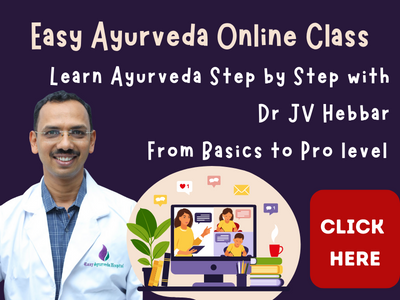Regimens and activities for those undergoing Snehana
Article by Dr Raghuram Y.S. MD (Ay) & Dr Manasa S, B.A.M.S
There are certain rules and regulations in relation to regimens and activities that one should strictly adhere to while undergoing snehana therapy or when snehapana is being taken as a preparatory therapy before administration of shodhana therapy (vamana and virechana).
In this article we shall touch upon those regimens and activities which are recommended and those activities contraindicated for persons undergoing snehana – oleation therapy.
The mentioned rules and regulations are applicable in all three phases / stages of snehana i.e. –
– before starting snehana – a day before or couple of days before starting the snehana
– during the phase of snehana – on all the days of consuming Sneha
– after snehana – even after completing the course of snehana, as a part of paschat karma i.e. follow up or post-treatment / snehana procedure
Note – though snehana is itself a purvakarma – preparatory procedure for panchakarma procedures like vamana and virechana, while consuming Sneha – snehana itself becomes a pradhana karma i.e. main procedure. Therefore, snehana procedure too will have certain dos and don’ts in relation to foods and activities which need to be strictly adhered to before (purvakarma) and after (paschat karma) snehapana.
Ref – Ashtanga Hridaya SutraSthana – Chapter 16, verses 26-29
Dos and Don’ts for those undergoing Snehana therapy
उष्णोदकोपचारी स्याद्ब्रह्मचारी क्षपाशयः।
न वेगरोधी व्यायामक्रोधशोकहिमातपान्॥२६॥
प्रवातयानाध्वभाष्यात्यासनसंस्थितीः।
नीचात्युञ्चोपधानाहःस्वप्नधूमरजांसि च॥२७॥
यान्यहानि पिबेत्तानि तावन्त्यन्यान्यपि त्यजेत्।
सर्वकर्मस्वयं प्रायो व्याधिक्षीणेषु च क्रमः॥२८॥
उपचारस्तु शमने कार्यः स्नेहे विरिक्तवत्।
a. Indicated regimen and activities
Ushna Udaka Upachari – the person should use only hot water or warm water for drinking and other purposes like bathing, washing hands etc. Hot water helps in proper digestion and absorption of Sneha. It is the best anupana – vehicle for Sneha, by default, if anything else is not mentioned. Cold water on the other hand would cause stambhana – stops or checks the natural movements in the gut and may cause complications.
Syad Brahmachari – one should maintain celibacy and abstain from sexual activities while consuming snehana. Sneha acts at the tissue levels. The doshas therein will be excited by the action of Sneha. In that condition when there is loss of shukra dhatu there will be pressure on the chain of tissues since formation of one dhatu is dependent on the other dhatu according to Ayurveda. This will create negative dynamics inside the tissues and the purpose of snehana will be nullified. Certain complications too might be caused.
Kshapashaya – one should stay inside their own places i.e. home or ward and not roam outside. They should also not sleep during day time and should not keep awake during night time. These restrictions are very important for the Sneha to act better. Staying inside the home or ward will give necessary rest and avoid exposure to wind or extreme heat. Day sleep will aggravate kapha. After snehana one would feel drowsy and heavy but should still not sleep and keep oneself alert. Keeping awake during night will aggravate vata and create vata disorders.
b. Indicated regimen and activities
Na Vegarodhi – one should not suppress natural urges. This will aggravate vata and cause udavarta i.e. upward movement of vata, which will cause a lot of complications and also hamper the action of Sneha.
Tyajet Vyayama Krodha Soka Hima Atapan – one should avoid indulgence in –
– excessive exercise, grief and cold – since they will aggravate vata
– anger and sunlight – since they will aggravate pitta
Aggravation of vata and pitta in the gut or system is not desirable for the action of Sneha. One also needs a calm mind and freedom from stress so as to enable proper action of the therapy. Control over anger and grief will help in that direction.
Tyajet Pravata Yana Adhva Bhasya Atyasana samsthitih – one should keep away from –
– exposure to heavy breeze,
– traveling in vehicles,
– walking long distances,
– speaking too much,
– being seated for prolonged time or
– keeping in uncomfortable positions for long time
While being seated for prolonged time increases kapha, the other activities would increase vata, both of which would meddle with action of Sneha.
Tyajet Nicha Ati Uncha Upadhana – one should not use pillows very low or very high beneath the head while sleeping. This will cause imbalances in vata.
Tyajet Swapna – one should avoid excessive day sleep, which will increase kapha. Increased kapha would come in the way of digestion and absorption of Sneha, since both are of similar qualities.
Tyajet Dhuma Rajamsi – one should avoid exposure or contact with smoke and dust. They will aggravate kapha and vata in the respiratory passages and cause conditions like kasa – cough and shwasa – breathing disorders. Snehana might have to be stopped in conditions of active symptoms. Cough etc. might also throw up the consumed Sneha.
Further on,
Acharya Vagbhata says that the above said dos and don’ts should not only be followed strictly on the days of consuming Sneha, but should also continue for the same number of days after finishing the Sneha therapy also. Example, if snehana is given for 5 days, the restrictions and indications shall be followed for the next 5 days after stoppage of snehana i.e. from day 6 to day 10.
He further says that the same regimens should generally be followed for all shodhana therapies including vamana, virechana, vasti etc. and also for those who are debilitated by the diseases.
In case of Shamana Sneha – oleation therapy given for palliative purpose, the regimens indicated for the persons who have undergone virechana – purgation therapy – should be administered.



